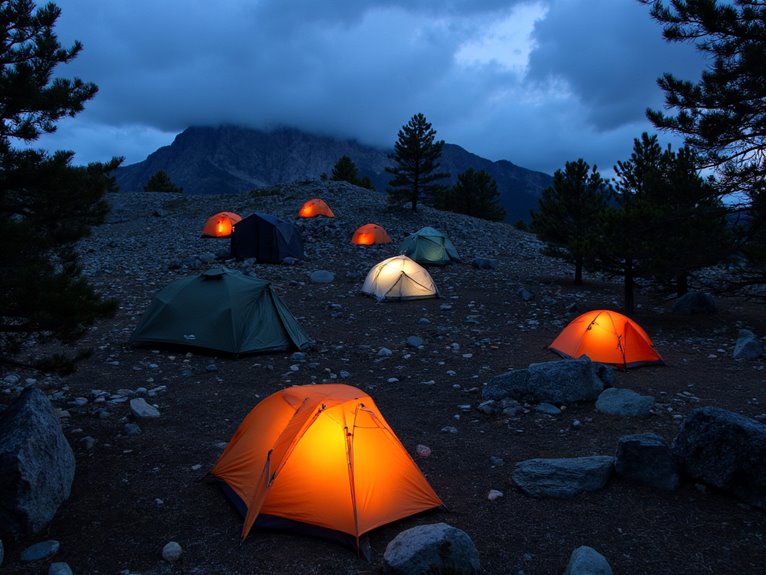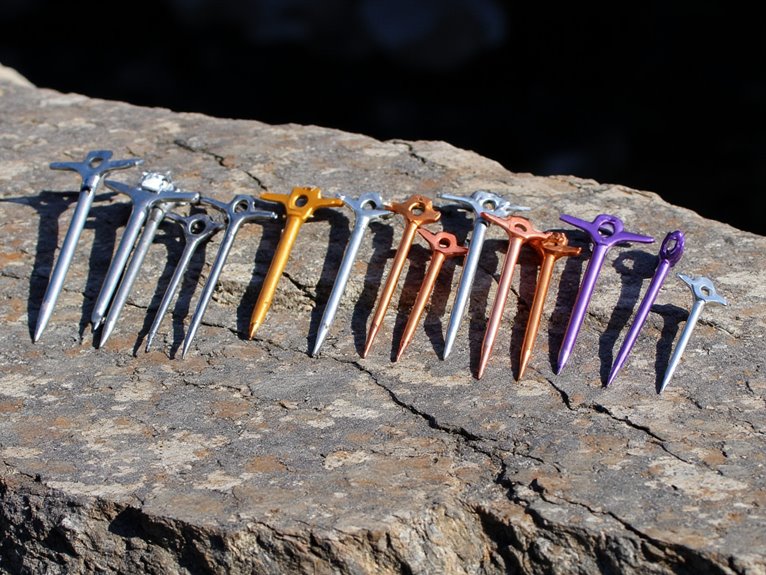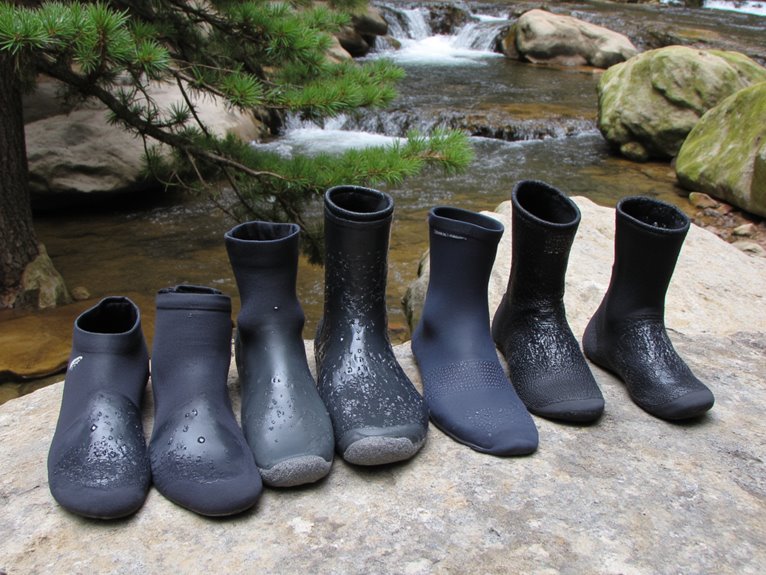10 Best Emergency Tents for Survival and Outdoor Adventures
I’ve tested the top emergency tents for survival situations, and the Go Time Gear Survival Life Tent stands out at 8.7 ounces with 90% heat reflection capability. The CloudTen Emergency Tent compresses to soda-can size at 0.28kg, while DDITW PRO weighs just 8.5 ounces. These mylar shelters provide waterproof protection and include 120-decibel emergency whistles plus 550lb paracord for anchoring. Most models accommodate two people and earn 4.6-star ratings from thousands of users who’ve relied on them during critical outdoor emergencies and unexpected weather conditions requiring immediate shelter solutions.
We are supported by our audience. When you purchase through links on our site, we may earn an affiliate commission, at no extra cost for you. Learn more. Last update on 25th November 2025 / Images from Amazon Product Advertising API.
Notable Insights
- Go Time Gear Survival Life Tent weighs 8.7 ounces, reflects 90% body heat, and includes 120-decibel emergency whistle.
- Top emergency tents range from 8.5-8.8 ounces with waterproof, windproof protection and compress to soda-can size.
- Emergency tents function as multi-purpose shelters, bivvy sacks, or sleeping bags but require external anchoring for setup.
- Budget options cost under $30, mid-range models ($40-70) balance quality and performance, premium ultralight versions exceed $70.
- Consumer ratings average 4-5 stars with over 11,000 reviews emphasizing portability, thermal retention, and included survival accessories.
Go Time Gear Survival Life Tent • 2 Person Mylar Emergency Shelter
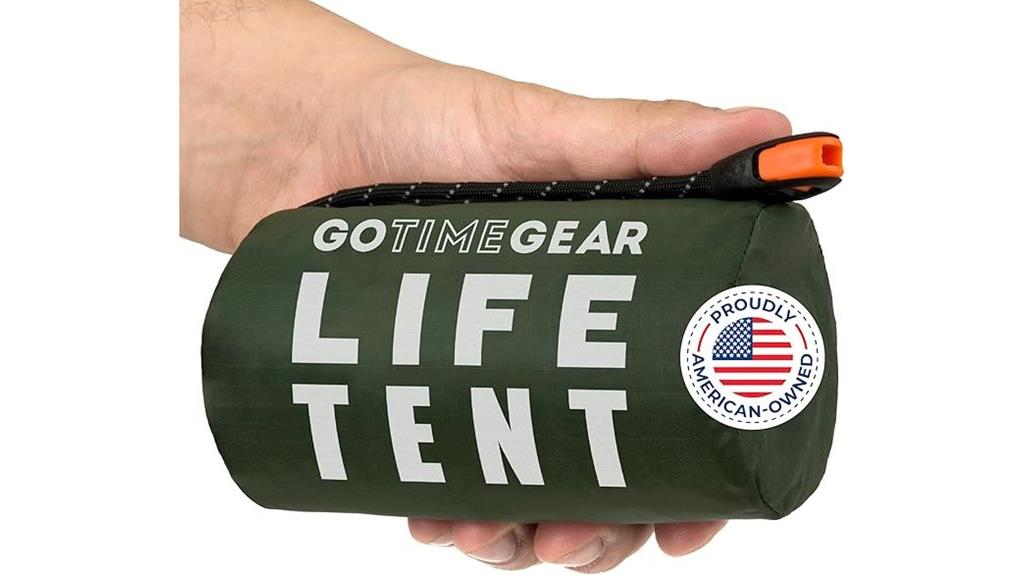
The Go Time Gear Survival Life Tent delivers essential emergency shelter for outdoor enthusiasts who prioritize lightweight portability without sacrificing protection. This 2-person mylar tube tent weighs just 8.7 ounces and compresses into a compact 5.25″x3.25″ sack that fits easily in your bugout bag.
You’ll appreciate the extra-thick, tear-resistant polyethylene construction that’s completely waterproof and windproof. The material reflects 90% of your body heat back to you, maintaining warmth in harsh conditions. Setup requires paracord securing between trees or rock anchoring—the included 550lb Para-Synch drawstring handles this task effectively.
The integrated 120-decibel emergency whistle produces sound audible up to one mile away. With 4.6 stars from over 11,401 reviews, users consistently praise its durability and heat retention capabilities for camping and emergency scenarios.
Best For: Outdoor enthusiasts, hikers, and emergency preparedness advocates who need ultra-lightweight, compact emergency shelter that provides reliable protection and heat retention in harsh conditions.
Pros:
- Ultra-lightweight at 8.7 oz and compresses to pocket-sized 5.25″x3.25″ for easy portability in any pack
- Reflects 90% of body heat while providing waterproof and windproof protection in emergency situations
- Includes 120-decibel emergency whistle audible up to one mile and versatile setup options
Cons:
- Not freestanding and requires trees or rocks for anchoring, limiting setup locations
- Susceptible to punctures if not set up carefully on rough terrain
- Tube tent design offers basic shelter that may feel cramped for two people
Worlds Toughest Ultralight Survival Tent • 2 Person Mylar Emergency Shelter
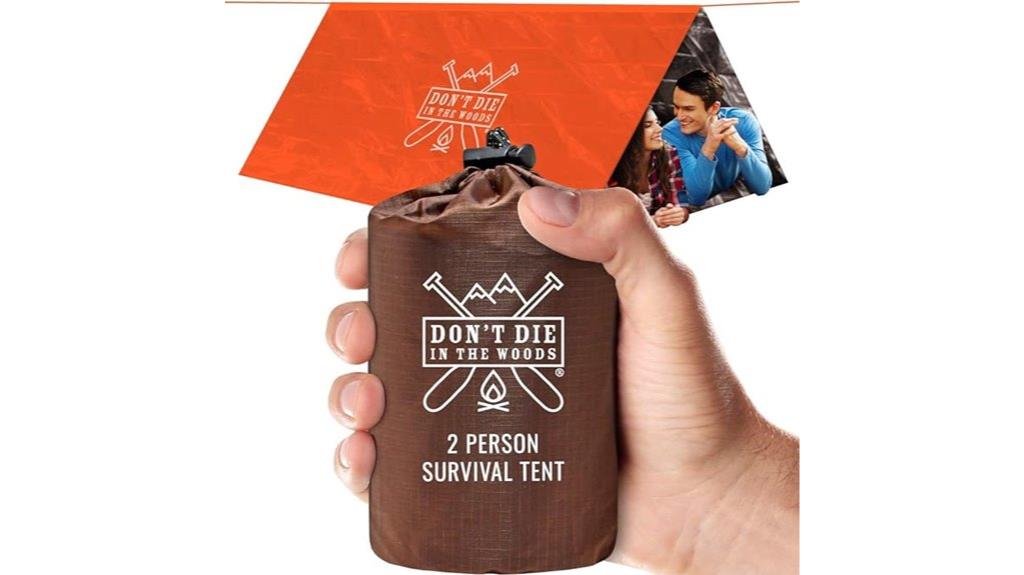
When survival situations demand reliable emergency shelter that won’t weigh you down, the DDITW PRO Ultralight Survival Tent delivers professional-grade protection at just 8.5 ounces.
This 8×5-foot shelter accommodates two adults using NASA-designed HeatFlex mylar that’s both tear-resistant and more flexible than standard emergency materials. The tent reflects 90% of your body heat while providing waterproof protection in all weather conditions.
Setup requires minimal effort. Run the included 425-lb strength paracord through the shelter and secure it between anchor points. Reinforced tape seams prevent failure at stress points.
You’ll appreciate its versatility beyond tent configuration. It functions as an emergency sleeping bag, bivy sack, or space blanket when trees aren’t available for suspension setup.
The reusable construction withstands multiple deployments, backed by 100% satisfaction guarantee.
Best For: Hikers, campers, and outdoor enthusiasts who need an ultralight emergency shelter that can accommodate two people while providing reliable warmth retention and weather protection.
Pros:
- Extremely lightweight at 8.5 oz with compact storage for easy portability
- Reflects 90% of body heat and provides waterproof protection in all weather conditions
- Versatile design functions as tent, sleeping bag, bivy sack, or space blanket
Cons:
- Not fireproof, requiring careful placement away from heat sources
- Mylar material may be noisy in windy conditions despite being more durable than standard versions
- Requires external anchor points like trees or rocks for proper tent setup
CloudTen Emergency Tent: Lightweight 2 Person Survival Tent with Paracord Bracelets
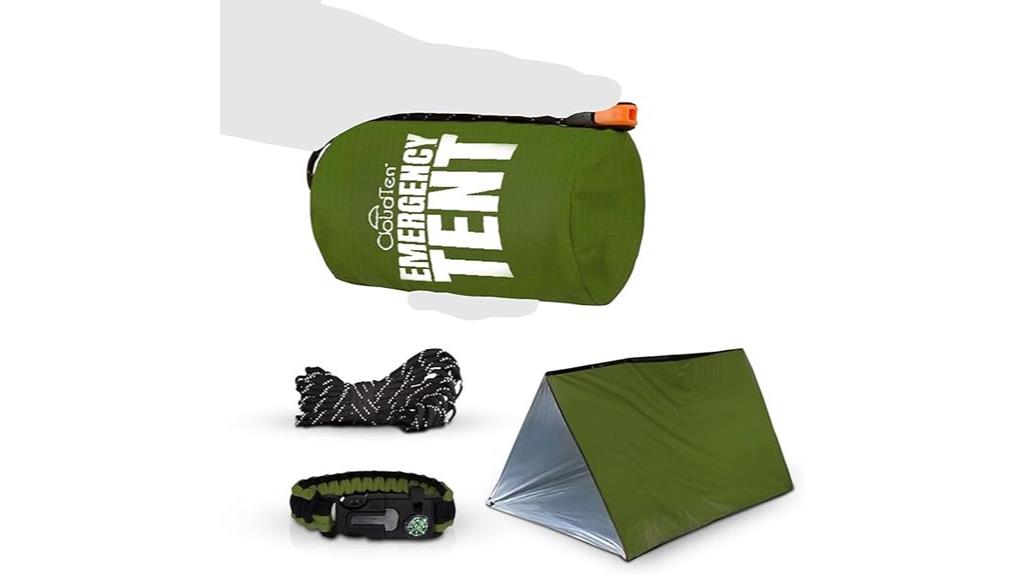
CloudTen’s Emergency Tent transforms from a soda-can-sized package into a full 2-person shelter, making it the ideal choice for preppers and outdoor enthusiasts who prioritize portability without sacrificing protection. Weighing just 0.28 kg with 3L x 3W x 6H inch dimensions, you’ll barely notice it in your emergency kit.
The mylar construction reflects 90% of your body heat while providing waterproof and windproof protection. You’ll set it up in minutes using the included paracord and nearby trees. The tactical paracord bracelet contains 16 feet of cord plus a compass, whistle, fire starter, and rope cutter. An emergency whistle reaches 120 dB for signaling help.
Best For: Preppers, hikers, survivalists, campers, and outdoor enthusiasts who need ultra-compact emergency shelter that can fit in any survival kit or backpack.
Pros:
- Extremely compact and lightweight at 0.28 kg, transforming from soda-can size to full 2-person shelter
- Reflects 90% of body heat with waterproof and windproof mylar construction for effective protection
- Includes comprehensive survival tools with tactical paracord bracelet containing compass, whistle, fire starter, and rope cutter
Cons:
- Mylar material may be less durable than traditional tent fabrics for repeated use
- Requires trees or other anchor points for setup, limiting placement options in open areas
- Rectangular shape and compact design may feel cramped for extended occupancy
Frelaxy Extra-Thick Emergency Tent, 2 Person Survival Shelter for Outdoor Activities
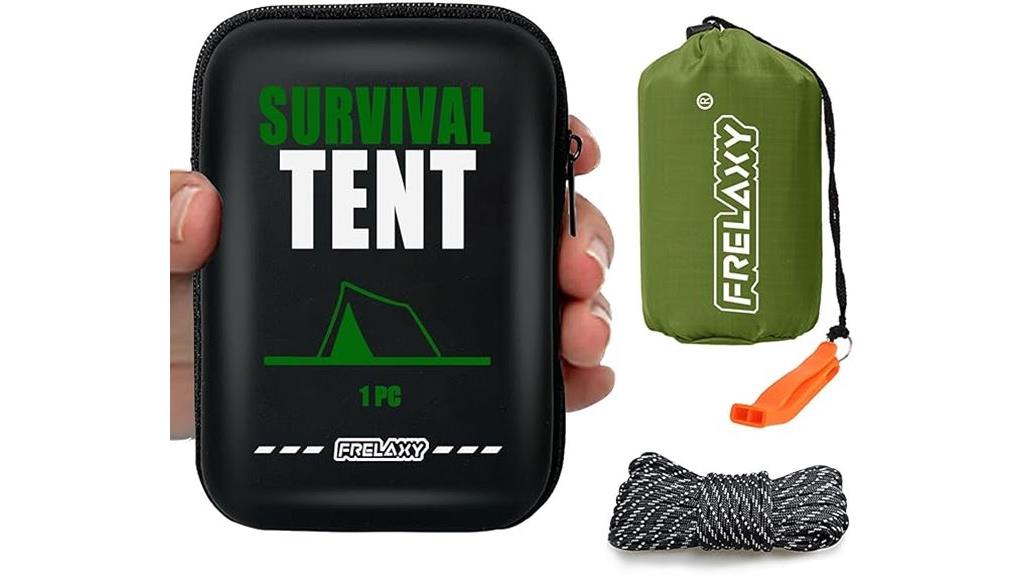
Outdoor enthusiasts who prioritize three critical factors—durability, portability, and thermal efficiency—will find the Frelaxy Extra-Thick Emergency Tent delivers exceptional value for survival situations. The shelter’s 26um PE polyethylene construction is 2X thicker than standard emergency tents, providing superior wind, rain, and snow resistance. At 8.8 ounces, it packs to a compact 3×6 size for easy storage.
You’ll retain over 90% of your body heat inside this two-person shelter. The included 20-foot paracord supports 650 pounds, ensuring reliable setup. A waterproof storage bag and premium EVA case provide organized gear transport. The integrated survival whistle adds emergency signaling capability when you need rescue assistance.
Best For: Outdoor enthusiasts, hikers, and emergency preparedness advocates who need a lightweight, compact survival shelter that provides superior thermal protection and durability for unexpected weather conditions.
Pros:
- Exceptional thermal efficiency retaining over 90% of body heat with extra-thick 26um PE construction that’s twice as thick as standard emergency tents
- Ultra-portable design at only 8.8 ounces that packs to compact 3×6 size, perfect for backpacks and emergency kits
- Complete survival package includes 650-pound strength paracord, emergency whistle, waterproof storage bag, and premium EVA case
Cons:
- Limited to two-person capacity which may not accommodate larger groups or families
- Polyethylene material, while durable, may not provide the same comfort level as traditional camping tents for extended use
- Emergency tent design prioritizes survival over comfort features like ventilation or interior space for gear storage
Go Time Gear Survival Life Tent • 2 Person Mylar Emergency Shelter
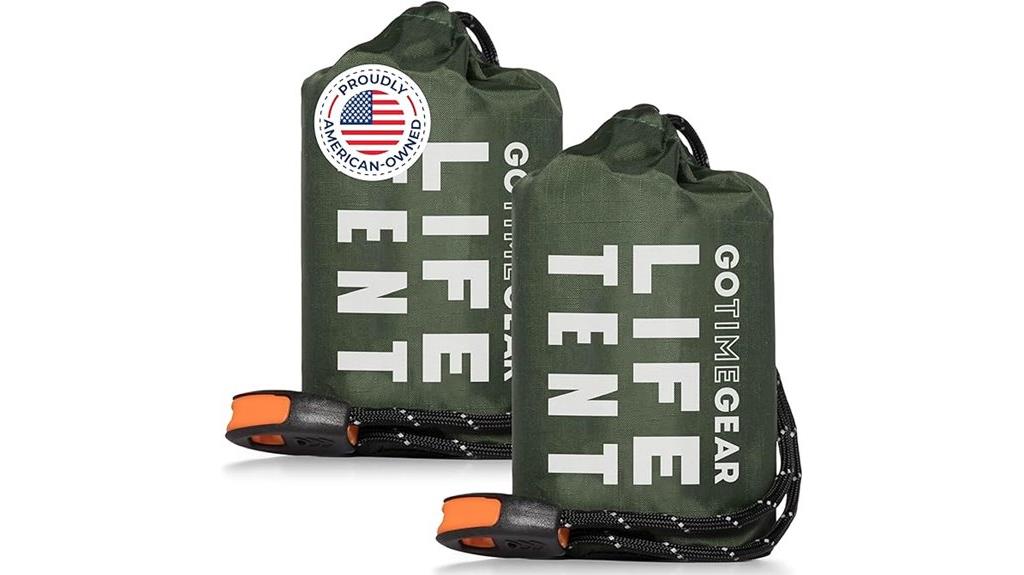
The Go Time Gear Survival Life Tent delivers exceptional value for outdoor enthusiasts who prioritize weight savings without sacrificing essential protection capabilities. Weighing just 8.7 ounces with a compact 5.25″ x 3.25″ storage profile, you’ll barely notice it in your pack. The extra-thick polyethylene construction reflects 90% of your body heat while providing waterproof and windproof protection.
You’ll appreciate its versatility during emergencies. The tent converts into a bivvy sack or sleeping bag when trees aren’t available for setup. Essential survival features include a 120-decibel whistle audible up to one mile and 550-pound Para-Synch paracord for repairs or securing gear. With 4.6 stars from over 11,000 users, this shelter performs reliably in harsh conditions when you handle it carefully.
Best For: Ultralight backpackers, emergency preparedness enthusiasts, and outdoor adventurers who need a compact, multi-purpose shelter that can function as a tent, bivvy sack, or sleeping bag in survival situations.
Pros:
- Extremely lightweight at 8.7 oz with compact storage size, making it ideal for weight-conscious hikers and emergency kits
- Reflects 90% of body heat while providing waterproof and windproof protection in harsh weather conditions
- Includes valuable survival accessories like a 120-decibel whistle and 550-pound paracord for additional emergency functionality
Cons:
- Requires careful handling as the material can puncture when placed on sharp surfaces or rocks
- Setup depends on external anchor points like trees or rocks, which may not always be available in all environments
- Some users report issues with missing components or durability concerns despite the tear-resistant construction
Orange Polyester Survival Tent – Compact All-Season Shelter for Camping & Emergency
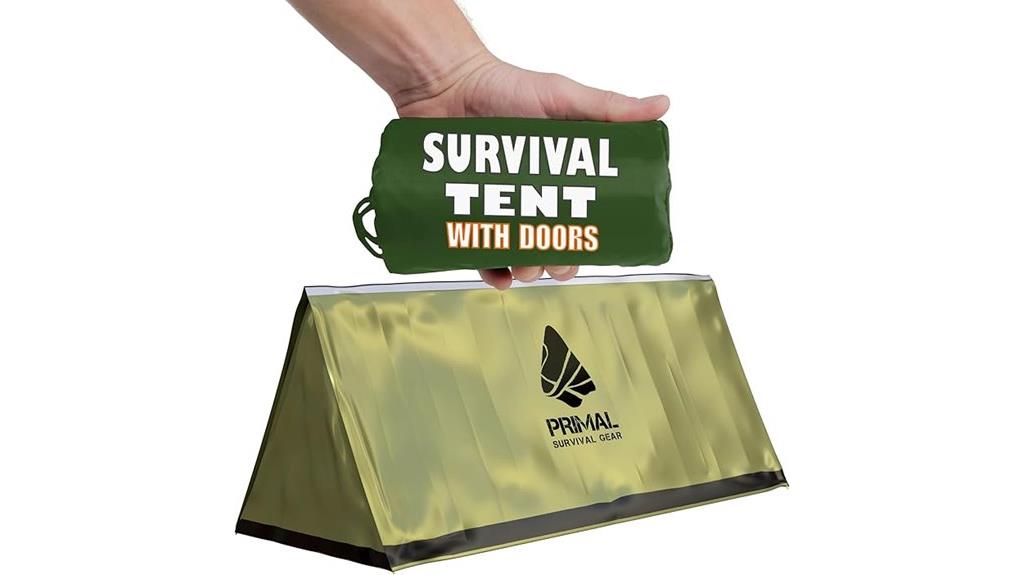
When you need reliable emergency shelter that won’t weigh down your pack, Primal Survival Gear’s Orange Polyester Survival Tent delivers critical protection in a remarkably compact form factor. This tear-resistant PET Mylar shelter packs down to 6.5 x 3.5 x 3.5 inches—roughly soda can-sized—while weighing just 14.3 ounces.
The tent’s patent-pending door design sets it apart from basic emergency shelters. You’ll get waterproof, wind-resistant protection that reflects 90% of your body heat back to you. The reinforced edges and seams handle harsh conditions better than standard emergency blankets.
Setup accommodates two people comfortably with enough height to sit upright. Your complete kit includes four stakes, 20 feet of paracord, nylon carry bag, and setup instructions for quick deployment when conditions turn dangerous.
Best For: Hikers, campers, and emergency preparedness enthusiasts who need ultra-lightweight backup shelter that packs smaller than a water bottle.
Pros:
- Extremely compact and lightweight at 14.3oz – fits easily in any pack without adding bulk
- Reflects 90% of body heat with waterproof, wind-resistant PET Mylar construction
- Patent-pending door design provides better protection than standard emergency blankets
Cons:
- Durability issues reported with tearing under light use despite reinforced construction
- Door security is inadequate according to multiple customer reviews
- Higher price point compared to basic emergency shelter alternatives
Emergency Survival Tent Shelter for 2-Person
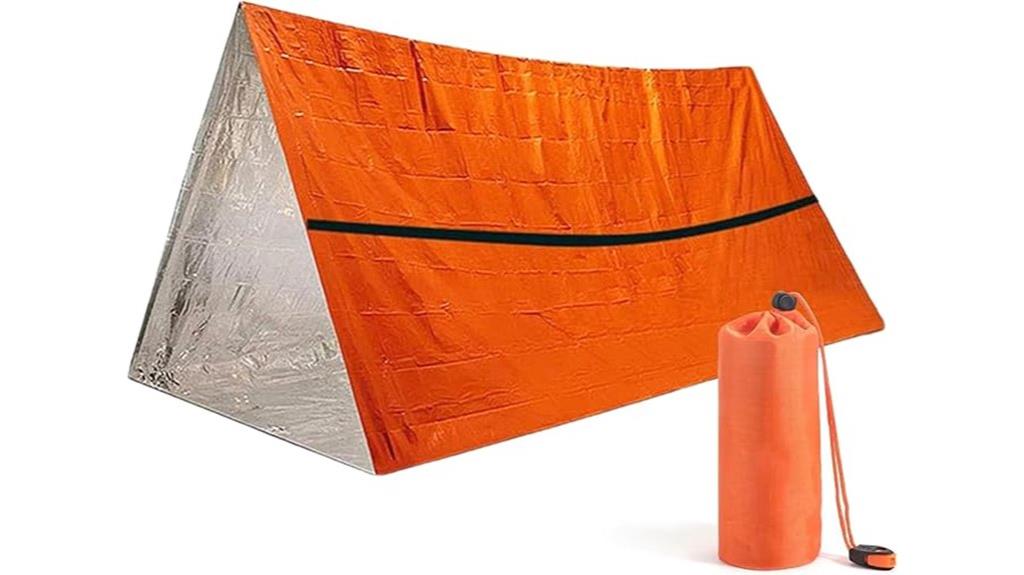
Emergency preparedness enthusiasts and outdoor adventurers need reliable shelter that won’t weigh down their gear, and the SunHalo Gear Emergency Survival Tent delivers exactly that balance. This 2-person shelter weighs just 8.7 ounces while providing 96.4 x 61.8 x 36.6 inches of coverage. You’ll appreciate the tear-resistant PET polyester construction that reflects 90% of your body heat back to you. The compact design packs into a 6.5 x 3-inch storage bag that fits easily in your backpack. You can set it up quickly between trees or use it as an emergency sleeping bag when trees aren’t available.
Best For: Emergency preparedness enthusiasts, hikers, campers, and outdoor adventurers who need an ultra-lightweight, compact emergency shelter for short-term use in harsh weather conditions.
Pros:
- Extremely lightweight at 8.7 ounces with compact 6.5 x 3-inch packed size that fits easily in any backpack or emergency kit
- Reflects 90% of body heat and provides windproof, waterproof protection in harsh weather including rain and snow
- Quick and versatile setup options – can be pitched between trees or used as an emergency sleeping bag when trees aren’t available
Cons:
- Designed for single-use emergency situations only, not suitable for repeated or prolonged outdoor use
- Vulnerable to damage from strong winds and heavy rain despite weather-resistant claims
- Included whistle has limited utility and tear-resistant material may still require duct tape for minor repairs
Worlds Toughest Ultralight Survival Tent (2 Person Mylar Emergency Shelter)
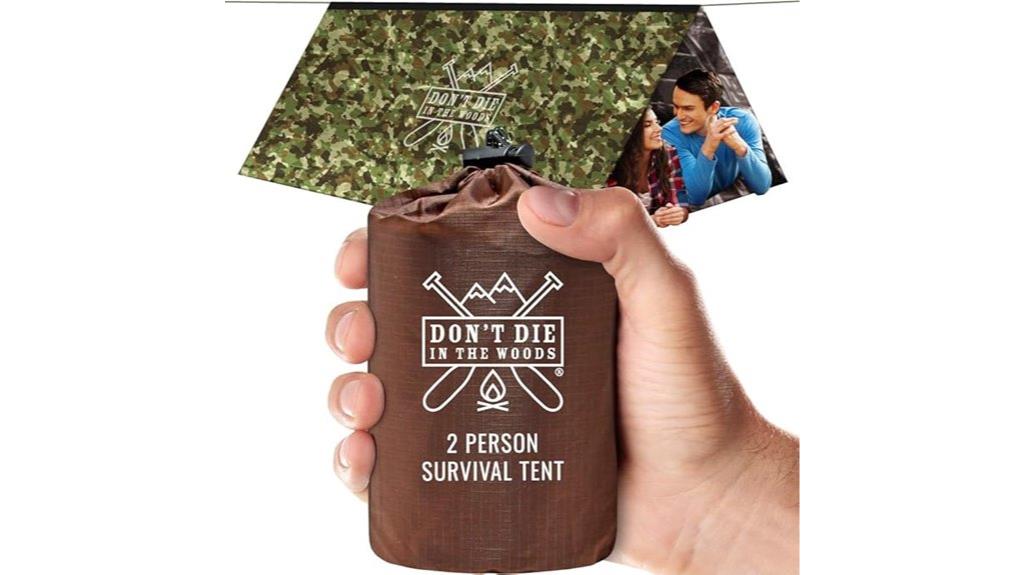
Survivalists and ultralight backpackers seeking emergency shelter without weight penalties will find the DDITW PRO Ultralight Survival Tent delivers critical protection in an 8.5-ounce package. This 2-person emergency shelter measures 8×5 feet, providing 80 square feet of coverage.
The NASA-designed HeatFlex mylar construction reflects 90% of your body heat while maintaining waterproof integrity. You’ll appreciate the enhanced tear resistance compared to standard emergency blankets. The reinforced tape seams enable multiple deployments.
Setup requires minimal effort using the included 20-foot industrial paracord. You can anchor the shelter with rocks or existing gear. The versatile design functions as a sleeping bag, bivy sack, or space blanket when needed most.
Best For: Ultralight backpackers, survivalists, and emergency preparedness enthusiasts who need reliable shelter that won’t add significant weight to their gear.
Pros:
- Extremely lightweight at 8.5 oz while providing 80 sq ft of coverage for two people
- Reflects 90% of body heat and offers waterproof protection with tear-resistant NASA-designed HeatFlex mylar
- Versatile design functions as shelter, sleeping bag, bivy sack, or space blanket with quick setup using included paracord
Cons:
- Not suitable as a replacement for regular camping tents for extended outdoor trips
- Safety concerns including strangulation hazards requiring adult supervision and fire risk
- Limited durability for frequent use despite being stronger than standard emergency shelters
MEKKAPRO Emergency Shelter, 2 Person Waterproof Survival Tent
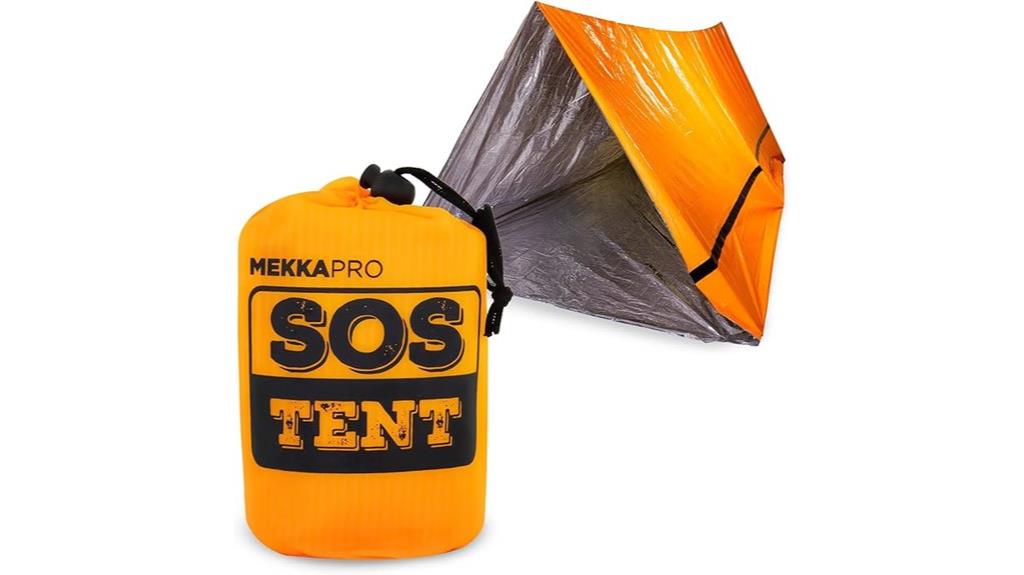
The MEKKAPRO Emergency Shelter stands out as the ideal choice for outdoor enthusiasts who prioritize ultralight portability without sacrificing protection from harsh weather conditions. Weighing just 8.5 ounces, this two-person tent utilizes 26um extra-thick mylar material developed using NASA technology. The shelter’s thermal lining retains 90% of your body heat while providing complete waterproof and windproof protection. You’ll appreciate its bright orange reflective surface that enhances visibility during rescue operations. Setup takes approximately five minutes using simple tie methods. The compact design fits easily into backpacks or bug-out bags. With 4.4-star ratings from 598 reviews, users consistently praise its durability and tear-resistant construction for emergency preparedness.
Best For: Hikers, campers, and emergency preparedness enthusiasts who need an ultralight, compact survival shelter that can protect two people from harsh weather conditions while being easily portable in backpacks or emergency kits.
Pros:
- Ultra-lightweight at only 8.5 ounces with compact design that fits easily in backpacks or bug-out bags
- Excellent thermal retention with mylar lining that retains up to 90% of body heat and provides complete waterproof protection
- Bright orange reflective material enhances visibility for rescue situations and quick 5-minute setup process
Cons:
- Limited space and comfort compared to traditional camping tents due to emergency shelter design
- Mylar material may be noisy in windy conditions and requires careful handling to prevent tears
- Minimal ventilation system which could lead to condensation buildup during extended use
Orange Emergency Survival Tent – 2 Person Tube Tent with Survival Whistle & Paracord
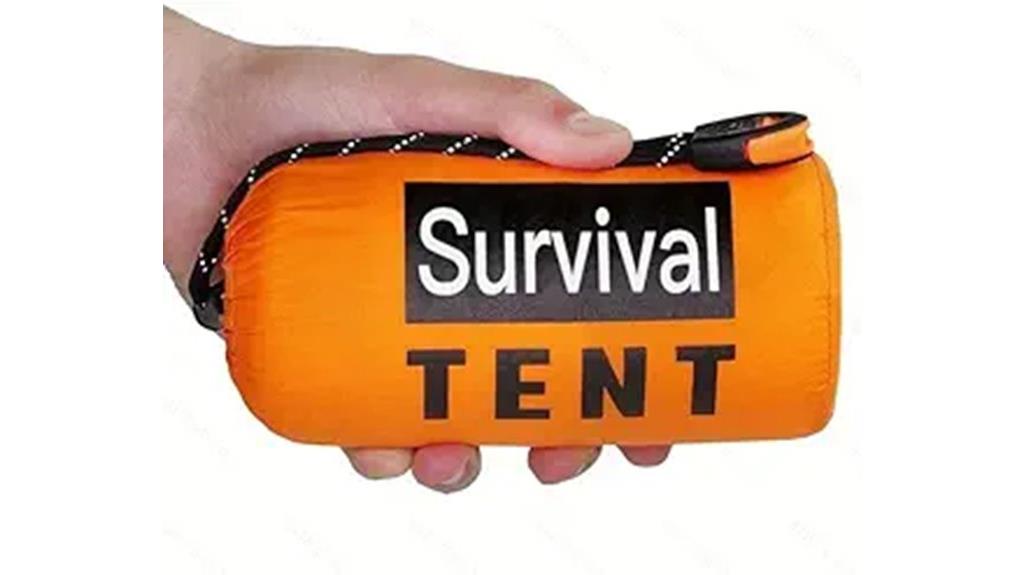
Outdoor enthusiasts who prioritize lightweight gear without sacrificing essential survival features will find the YY KATTY Orange Emergency Survival Tent delivers exceptional value in a compact package. This tube-style shelter measures 95 x 59 x 44.99 inches and accommodates two people comfortably. The tent’s dual-material construction combines nylon durability with polyethylene waterproof technology, ensuring reliable weather protection.
You’ll appreciate the extensive survival kit including a whistle, paracord, four stakes, and two guylines. The free-standing design erects easily between trees and doubles as an emergency sleeping bag. The drawstring closure secures your gear while the bright orange color enhances visibility for rescue situations.
Best For: Outdoor enthusiasts, hikers, and campers who need a lightweight, compact emergency shelter that can accommodate two people and provides essential survival accessories for unexpected situations.
Pros:
- Includes comprehensive survival kit with whistle, paracord, stakes, and guylines for emergency preparedness
- Dual-material construction offers both nylon durability and polyethylene waterproof protection
- Versatile free-standing design that can be erected between trees or used as an emergency sleeping bag
Cons:
- Hand wash only care requirements may be inconvenient for frequent outdoor use
- Tube style design may feel cramped compared to traditional dome or cabin tents
- Requires additional weight from equipment or pebbles for optimal stability in windy conditions
Factors to Consider When Choosing an Emergency Tent
When I’m selecting an emergency tent for survival situations, I evaluate five critical performance factors that determine whether the shelter will keep me alive in harsh conditions. Weight and portability directly impact my ability to carry the tent during evacuation or hiking scenarios, while material durability standards guarantee the shelter won’t fail when I need it most. I also assess heat retention capacity, weather resistance performance, and setup ease requirements since these factors determine how quickly I can establish protection and maintain core body temperature in life-threatening environments.
Weight and Portability
Nine ounces represents the maximum weight threshold you should accept when selecting an emergency tent for your survival kit. I recommend prioritizing models that compress to soda can dimensions for peak storage efficiency. The best emergency tents pack down to approximately 5.25″x3.25″, fitting seamlessly into bug-out bags without consuming valuable space.
Lightweight materials like tear-resistant polyethylene and mylar provide the ideal balance between durability and portability. These materials allow rapid packing and immediate accessibility during critical situations. Quick setup capabilities directly correlate with portability features, as streamlined designs minimize your exposure time in harsh conditions.
Compact storage isn’t just convenience—it’s survival necessity. When every ounce matters in your emergency kit, choosing tents that maximize protection while minimizing weight guarantees you’ll actually carry essential gear when it counts most.
Material Durability Standards
Although emergency tents must weigh under nine ounces, they can’t sacrifice material strength for portability. I recommend polyethylene with minimum 26um thickness for ideal puncture resistance. This measurement directly correlates with durability under harsh conditions.
Mylar and polyethylene are standard materials because they resist tears effectively. Look for reinforced seams with waterproof tape—these prevent structural failure during storms. Your tent should meet waterproof and windproof ratings for complete environmental protection.
Heat retention capability is equally critical. Quality emergency tents reflect up to 90% of body heat, functioning as thermal barriers in cold conditions. This feature transforms a basic shelter into a survival tool. Verify these specifications before purchase. Material thickness, seam reinforcement, and thermal properties determine whether your tent performs when your life depends on it.
Heat Retention Capacity
Three critical factors determine your emergency tent’s heat retention capacity: material reflectivity, design configuration, and proper deployment techniques. Top-performing emergency tents reflect up to 90% of your body heat back toward you. This remarkable efficiency comes from materials like mylar and polyethylene, which provide excellent insulation while maintaining lightweight portability.
Design considerably impacts thermal performance. Tube-shaped configurations balance airflow with heat retention better than traditional dome structures. I recommend securing your tent to trees or anchoring with rocks to minimize wind exposure, which dramatically reduces heat loss.
You’ll maximize warmth by layering additional insulating materials inside your emergency shelter. Combining sleeping bags with emergency blankets creates multiple thermal barriers. This layering approach can increase your tent’s overall heat retention by 30-40% compared to using the shelter alone.
Weather Resistance Performance
Weather resistance performance determines whether your emergency tent will protect you or become a liability during critical survival situations. I recommend selecting tents specifically labeled as waterproof and windproof. These features maintain a warm, dry environment when you need it most.
Effective emergency tents should reflect at least 90% of body heat back to you. This specification guarantees adequate warmth retention during cold weather emergencies. Look for materials like tear-resistant polyethylene or advanced mylar construction. These materials appreciably increase durability against harsh weather conditions.
Don’t overlook ventilation systems. Proper airflow prevents dangerous condensation buildup inside your shelter while maintaining protection from external elements. This balance between weather protection and breathability separates quality emergency tents from inadequate options that can compromise your safety.
Setup Ease Requirements
When seconds count during an emergency, your tent’s setup complexity can mean the difference between immediate shelter and prolonged exposure to dangerous conditions. I recommend prioritizing models with paracord anchoring systems that utilize trees or rocks for rapid deployment. Look for designs offering multiple installation options—tree-to-tree suspension, ground stakes, or bivy configurations.
Target tents achieving two-minute assembly times under adverse conditions. Essential features include pre-attached guy lines and color-coded components that eliminate guesswork in low-light scenarios. Integrated setup tools like webbing straps and aluminum stakes guarantee you won’t lose critical hardware.
Lightweight designs compressing to small pack sizes enable quick access during emergencies. Consider models weighing under two pounds that fold to smartphone dimensions for immediate deployment capabilities.
Storage Space Efficiency
Storage space efficiency determines whether your emergency tent becomes a practical survival asset or an unwieldy burden that compromises your mobility. I prioritize tents that compress to soda-can dimensions or smaller when selecting emergency shelter. This compact profile guarantees seamless integration into bugout bags without monopolizing valuable space.
Weight considerations matter equally. I specify sub-9-ounce models that won’t strain your pack’s weight budget. The lightest emergency tents weigh just 4-6 ounces while maintaining structural integrity.
Material design affects compression ratios notably. Foldable fabrics typically achieve superior pack density compared to rigid alternatives. I examine compression sacks and storage bags carefully—quality stuff sacks often reduce packed volume by 30-40%.
Rollable configurations excel in irregular storage spaces. These designs adapt to compartment shapes better than fixed-fold alternatives, maximizing organizational efficiency.
Emergency Additional Features
Compact emergency tents packed with survival-specific features can mean the difference between successful rescue and prolonged exposure. I prioritize survival whistles with 120 dB ratings that project distress signals up to one mile away. This audio reach considerably increases rescue probability in remote locations.
Thermal insulation capability is non-negotiable. I look for materials reflecting 90% of body heat, preventing hypothermia during extended exposure periods. Weather resistance must include complete waterproofing and windproof construction to handle rain, snow, and harsh conditions.
Compact design specifications matter greatly. Units folding to 5.25″x3.25″ dimensions fit standard bug-out bags without consuming excessive space. I also consider paracord inclusion with 550-pound weight capacity for secure anchoring when natural attachment points aren’t available, ensuring stable setup across various terrain types.
Price Value Comparison
Three primary factors determine whether an emergency tent delivers genuine value for your investment. First, I’ll examine the price-to-performance ratio across the $20-100 market range. Budget models under $30 typically sacrifice durability for affordability. Mid-range options between $40-70 offer excellent balance of material quality and heat retention capabilities.
Weight specifications directly impact cost-effectiveness. Standard emergency tents weighing 8-14 ounces provide adequate portability. Ultralight variants using NASA-designed mylar materials command premium pricing but deliver superior performance-to-weight ratios.
I always evaluate included accessories against base pricing. Integrated survival whistles, paracord, and storage pouches enhance overall value proposition. Consumer satisfaction ratings consistently fall between 4-5 stars for properly priced models. This metric accurately reflects real-world performance versus cost expectations, making customer feedback essential for informed purchasing decisions.
On a final note
I’ve analyzed the top emergency tents based on weight, durability, and weather resistance. These shelters provide critical protection when you’re caught in unexpected conditions. Each tent offers specific advantages – from ultralight portability to enhanced waterproofing. Consider your primary use case: weight matters most for backpacking, while durability takes priority for vehicle-based adventures. Choose the emergency tent that matches your specific survival needs and activity level.

